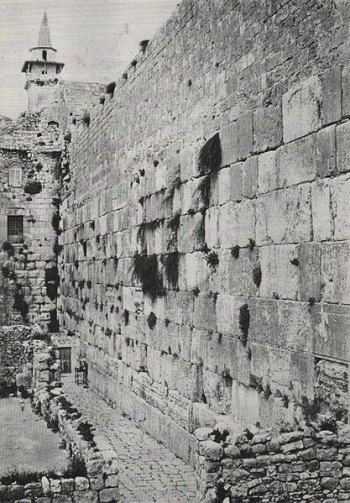Because it now forms part of a larger area�known as the Temple Mount by Jews and as al-Haram al-Sharif by Muslims�surrounding the Muslim Dome of the Rock and al-Aqsa Mosque, the two groups have often vied for control of it. When Israel captured the Old City in the Six-Day War (1967), the Jews once more gained authority over the site.
Jewish men and women can be found praying at the wall at every hour, though a mechitza, or divider, separates the men's section of the wall from the women's section. People of various ages travel from all over the world to have their ceremonies at the Kotel. It is also a tradition to deposit slips of paper with wishes or prayers on them in the crevices and crannies of the wall. Looking closely, one can see hundreds of tiny, folded papers stuffed inside every space that will hold them.
When Rome destroyed the Second Temple in 70 C.E., only one outer wall remained standing. The Romans probably would have destroyed that wall as well, but it must have seemed too insignificant to them; it was not even part of the Temple itself, just an outer wall surrounding the Temple Mount. For the Jews, however, this remnant of what was the most sacred building in the Jewish world quickly became the holiest spot in Jewish life. Throughout the centuries Jews from throughout the world made the difficult pilgrimage to Palestine, and immediately headed for the Kotel ha-Ma'aravi (the Western Wall) to thank God. The prayers offered at the Kotel were so heartfelt that gentiles began calling the site the "Wailing Wall." This undignified name never won a wide following among traditional Jews; the term "Wailing Wall" is not used in Hebrew.
The Western Wall was subjected to far worse than semantic indignities. During the more than one thousand years Jerusalem was under Muslim rule, the Arabs often used the Wall as a garbage dump, so as to humiliate the Jews who visited it
The Western ("Wailing") Wall is one of Israel's biggest tourist attractions. At all hours of the day or night, visitors stream to the Wall to pray, to take photographs, to participate in a demonstration or an army swearing-in ceremony, to attend a Bar Mitzva or just to absorb some of the historic and spiritual atmosphere that permeates the ancient site.
Jewish men and women can be found praying at the wall at every hour, though a mechitza, or divider, separates the men's section of the wall from the women's section. People of various ages travel from all over the world to have their ceremonies at the Kotel. It is also a tradition to deposit slips of paper with wishes or prayers on them in the crevices and crannies of the wall. Looking closely, one can see hundreds of tiny, folded papers stuffed inside every space that will hold them.
When Rome destroyed the Second Temple in 70 C.E., only one outer wall remained standing. The Romans probably would have destroyed that wall as well, but it must have seemed too insignificant to them; it was not even part of the Temple itself, just an outer wall surrounding the Temple Mount. For the Jews, however, this remnant of what was the most sacred building in the Jewish world quickly became the holiest spot in Jewish life. Throughout the centuries Jews from throughout the world made the difficult pilgrimage to Palestine, and immediately headed for the Kotel ha-Ma'aravi (the Western Wall) to thank God. The prayers offered at the Kotel were so heartfelt that gentiles began calling the site the "Wailing Wall." This undignified name never won a wide following among traditional Jews; the term "Wailing Wall" is not used in Hebrew.
The Western Wall was subjected to far worse than semantic indignities. During the more than one thousand years Jerusalem was under Muslim rule, the Arabs often used the Wall as a garbage dump, so as to humiliate the Jews who visited it
The Western ("Wailing") Wall is one of Israel's biggest tourist attractions. At all hours of the day or night, visitors stream to the Wall to pray, to take photographs, to participate in a demonstration or an army swearing-in ceremony, to attend a Bar Mitzva or just to absorb some of the historic and spiritual atmosphere that permeates the ancient site.
Kotel - It is the holy place most venerated by Jews, as it is the only remnant of the Second Temple, which was destroyed by the Romans in A.D. 70. It is the focus of Jewish prayer, the place where - throughout the ages - Jews have expressed their grief over the destruction of the Temple and long the exile and their hope for their eventual return to the Holy Land.
The Western Wall is part of the bigger religious site in the Old City of Jerusalem called Har ha-Bayit (the Temple Mount) to Jews and Christians, or Al-Haram al-Qudsi al-Sharif (the Noble Sanctuary) to Muslims. The Western Wall derives its holiness due to its proximity to the sacred Holy of Holies on the Temple Mount, which is the Most Holy Place in Judaism. This makes the Western Wall the holiest location in Judaism that is currently generally accessible to the Jewish people for prayer.
The Western Wall is part of the bigger religious site in the Old City of Jerusalem called Har ha-Bayit (the Temple Mount) to Jews and Christians, or Al-Haram al-Qudsi al-Sharif (the Noble Sanctuary) to Muslims. The Western Wall derives its holiness due to its proximity to the sacred Holy of Holies on the Temple Mount, which is the Most Holy Place in Judaism. This makes the Western Wall the holiest location in Judaism that is currently generally accessible to the Jewish people for prayer.

The Western Wall Hebrew - HaKotel HaMa'aravi, Wailing Wall or simply The Kotel, is a retaining wall in Jerusalem that dates from the time of the Jewish Second Temple 516 BCE-70CE. The Western ("Wailing") Wall is the holiest shrine of the Jewish world, is a continuation of the western wall which surrounded the ancient Temple Area, built by King Herod in the 1st century B.C.
Location of Western Wall: The Western wall is located on the western side of the temple mount, in the heart of old Jerusalem.
Location of Western Wall: The Western wall is located on the western side of the temple mount, in the heart of old Jerusalem.
Advertisement
Searches related to: Western Wall Jerusalem
Dome of the rock
Temple mount
Western wall tours
Western wall camera
Western wall heritage foundation
The Western wall history
The wailing wall Israel
Dome of the rock
Temple mount
Western wall tours
Western wall camera
Western wall heritage foundation
The Western wall history
The wailing wall Israel

Navigation
Kotel
Travel Partners

Western Wall Prayer
Western Wall Video
From Jaffa Gate to the Western Wall, explore the beautiful City of David as Barry Segal walks you through Armenian ceramic shops, the best carrot cake cafe and the Western Wall tunnels...also enjoy a musical interlude with Batya and Barry singing On Your Walls O Jerusalem!
The Western Wall Jerusalem
Western Wall Jerusalem
| Browse our free encyclopedia by alphabet: A B C D E F G H I J K L M N O P Q R S T U V W X Y Z |
| Join the Club for more information about Western Wall Jerusalem Log In |
| Join the Club - Advertise With Us - Contact Us - Links - Privacy Policy JERUSALEMPEDIA.All Rights Reserved. |
| The biggest Jerusalem content encyclopedia on the Internet. Jerusalempedia.com is a site that offers a full range of terms related to Jerusalem. Our Mission is to create the most comprehensive and definitive source of information available on Jerusalem anywhere. We are in the process of compiling the world's most comprehensive source of inter-related encyclopedic information sources covering every subject of Jerusalem to our visitors. |

The Western Wall Jerusalem in 1870

